Analyzing Positivism's Role in Modern Criminology (Course CRIM101)
VerifiedAdded on 2020/04/21
|8
|1858
|144
Essay
AI Summary
This essay critically analyzes the theory of positivism in criminology. It begins by outlining the historical context of positivism, contrasting it with classicism and highlighting its focus on scientific objectivity and the application of scientific principles to understand and reduce crime. The essay discusses the core assumptions of positivists, including the use of quantitative data and deductive reasoning. It then explores the advantages of positivism, such as its structured approach and reliance on quantitative methods, while also examining its disadvantages, including its inflexibility and potential disregard for human behavior. The essay considers criticisms of positivism, including its limitations in addressing complex social factors and its tendency to overlook individual differences. The paper concludes by arguing that positivism, despite its criticisms, remains a practical and influential approach to criminology, emphasizing its scientific methodology and continuous development. References from various criminology scholars and authors have been incorporated to support the arguments and analysis.
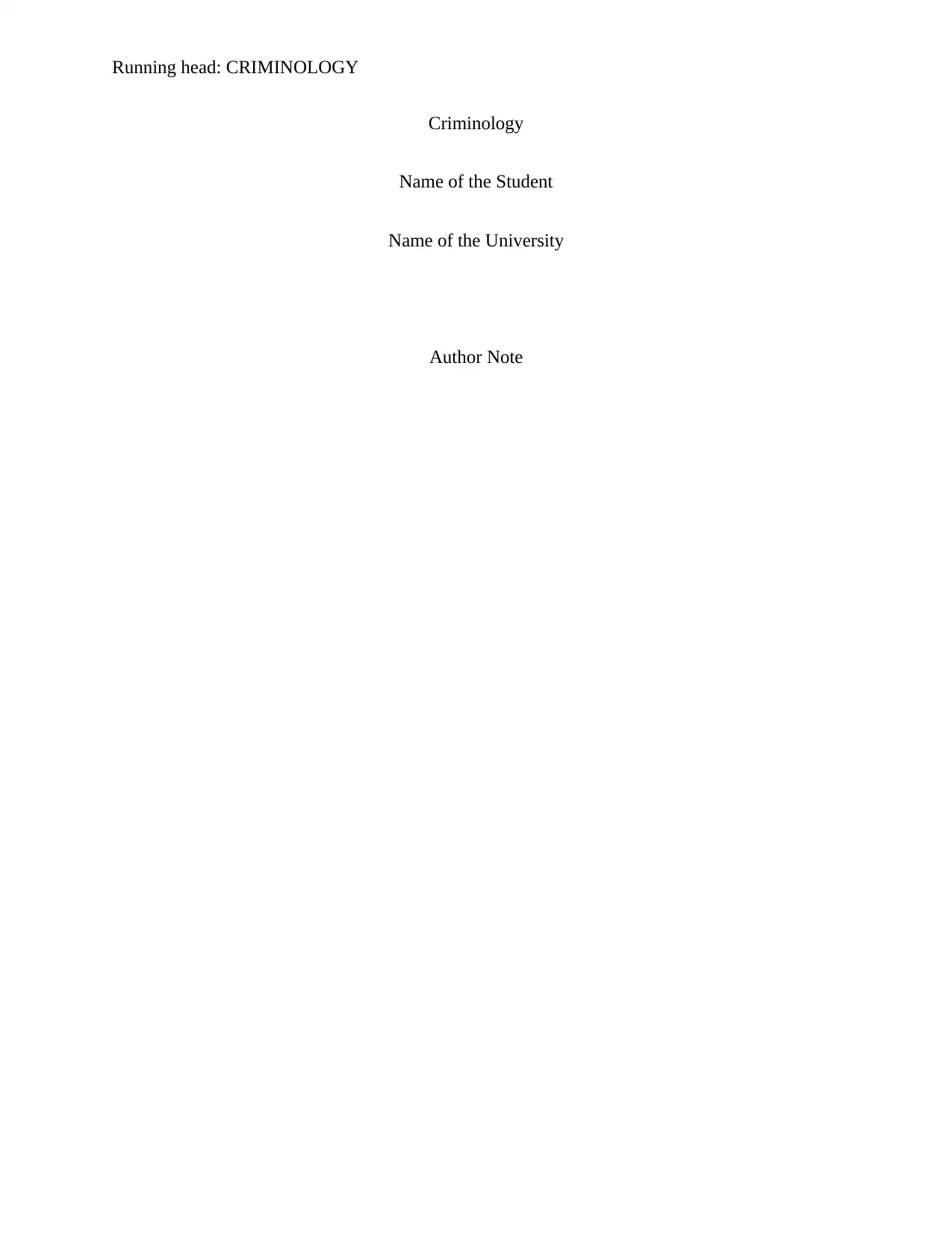
Running head: CRIMINOLOGY
Criminology
Name of the Student
Name of the University
Author Note
Criminology
Name of the Student
Name of the University
Author Note
Paraphrase This Document
Need a fresh take? Get an instant paraphrase of this document with our AI Paraphraser
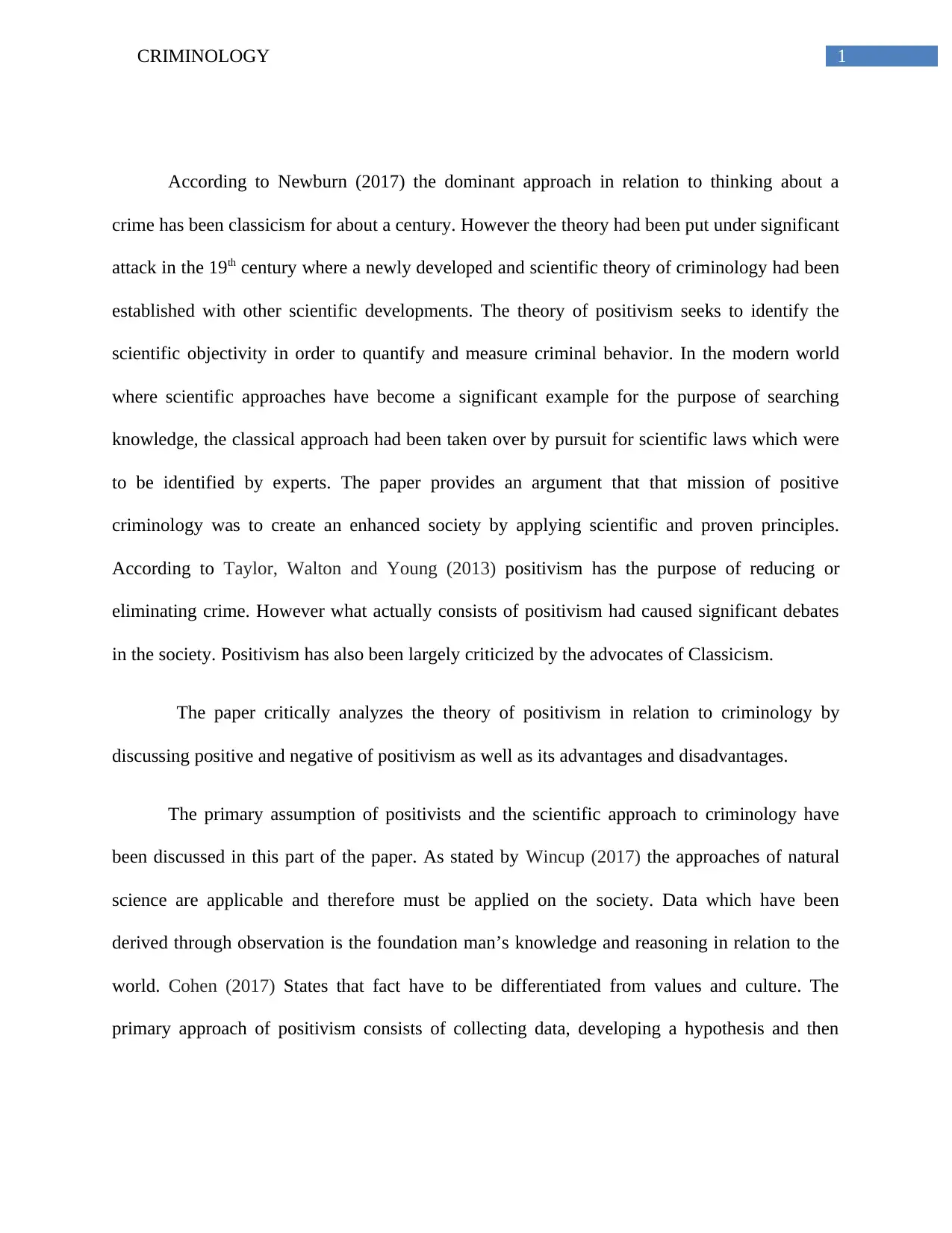
1CRIMINOLOGY
According to Newburn (2017) the dominant approach in relation to thinking about a
crime has been classicism for about a century. However the theory had been put under significant
attack in the 19th century where a newly developed and scientific theory of criminology had been
established with other scientific developments. The theory of positivism seeks to identify the
scientific objectivity in order to quantify and measure criminal behavior. In the modern world
where scientific approaches have become a significant example for the purpose of searching
knowledge, the classical approach had been taken over by pursuit for scientific laws which were
to be identified by experts. The paper provides an argument that that mission of positive
criminology was to create an enhanced society by applying scientific and proven principles.
According to Taylor, Walton and Young (2013) positivism has the purpose of reducing or
eliminating crime. However what actually consists of positivism had caused significant debates
in the society. Positivism has also been largely criticized by the advocates of Classicism.
The paper critically analyzes the theory of positivism in relation to criminology by
discussing positive and negative of positivism as well as its advantages and disadvantages.
The primary assumption of positivists and the scientific approach to criminology have
been discussed in this part of the paper. As stated by Wincup (2017) the approaches of natural
science are applicable and therefore must be applied on the society. Data which have been
derived through observation is the foundation man’s knowledge and reasoning in relation to the
world. Cohen (2017) States that fact have to be differentiated from values and culture. The
primary approach of positivism consists of collecting data, developing a hypothesis and then
According to Newburn (2017) the dominant approach in relation to thinking about a
crime has been classicism for about a century. However the theory had been put under significant
attack in the 19th century where a newly developed and scientific theory of criminology had been
established with other scientific developments. The theory of positivism seeks to identify the
scientific objectivity in order to quantify and measure criminal behavior. In the modern world
where scientific approaches have become a significant example for the purpose of searching
knowledge, the classical approach had been taken over by pursuit for scientific laws which were
to be identified by experts. The paper provides an argument that that mission of positive
criminology was to create an enhanced society by applying scientific and proven principles.
According to Taylor, Walton and Young (2013) positivism has the purpose of reducing or
eliminating crime. However what actually consists of positivism had caused significant debates
in the society. Positivism has also been largely criticized by the advocates of Classicism.
The paper critically analyzes the theory of positivism in relation to criminology by
discussing positive and negative of positivism as well as its advantages and disadvantages.
The primary assumption of positivists and the scientific approach to criminology have
been discussed in this part of the paper. As stated by Wincup (2017) the approaches of natural
science are applicable and therefore must be applied on the society. Data which have been
derived through observation is the foundation man’s knowledge and reasoning in relation to the
world. Cohen (2017) States that fact have to be differentiated from values and culture. The
primary approach of positivism consists of collecting data, developing a hypothesis and then
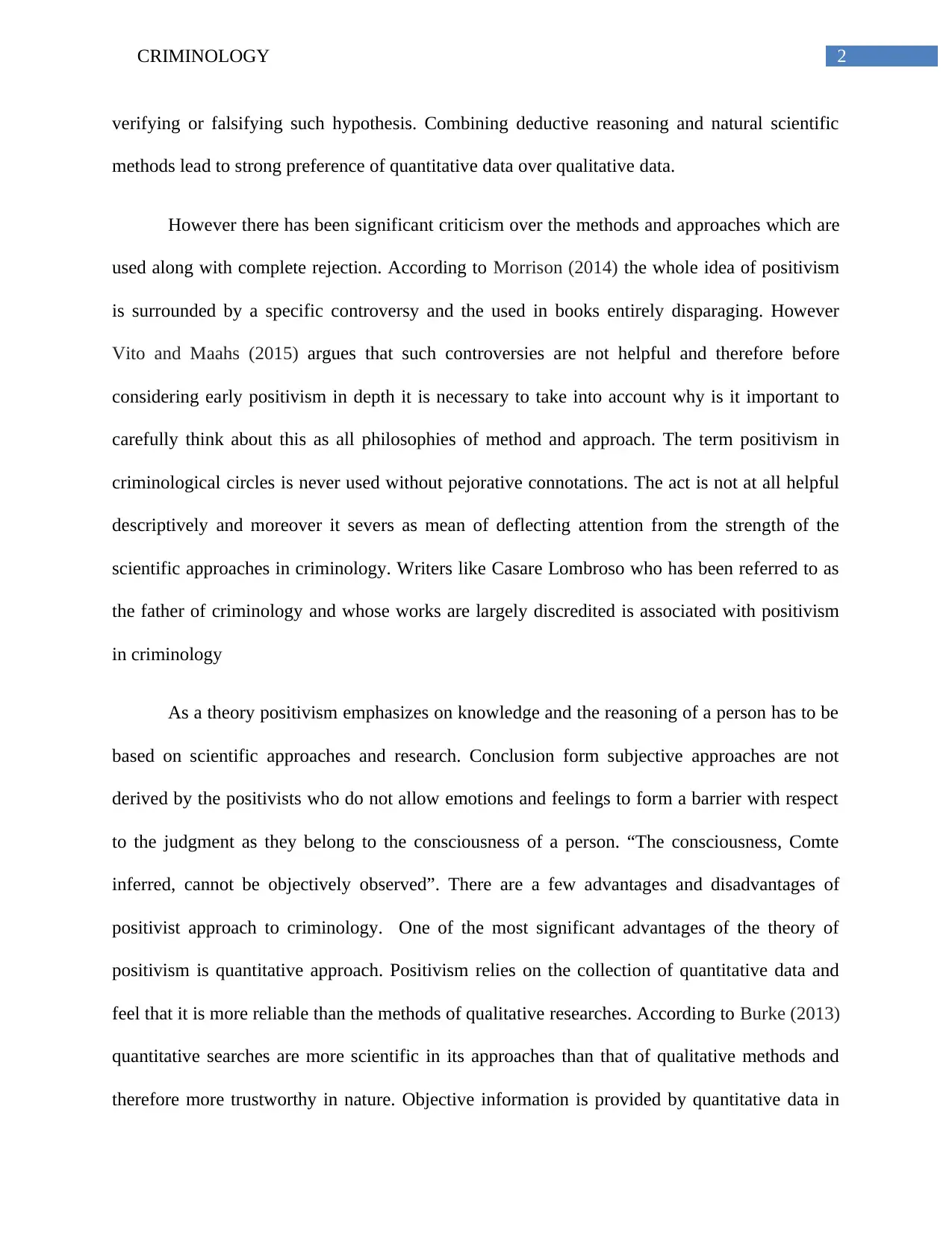
2CRIMINOLOGY
verifying or falsifying such hypothesis. Combining deductive reasoning and natural scientific
methods lead to strong preference of quantitative data over qualitative data.
However there has been significant criticism over the methods and approaches which are
used along with complete rejection. According to Morrison (2014) the whole idea of positivism
is surrounded by a specific controversy and the used in books entirely disparaging. However
Vito and Maahs (2015) argues that such controversies are not helpful and therefore before
considering early positivism in depth it is necessary to take into account why is it important to
carefully think about this as all philosophies of method and approach. The term positivism in
criminological circles is never used without pejorative connotations. The act is not at all helpful
descriptively and moreover it severs as mean of deflecting attention from the strength of the
scientific approaches in criminology. Writers like Casare Lombroso who has been referred to as
the father of criminology and whose works are largely discredited is associated with positivism
in criminology
As a theory positivism emphasizes on knowledge and the reasoning of a person has to be
based on scientific approaches and research. Conclusion form subjective approaches are not
derived by the positivists who do not allow emotions and feelings to form a barrier with respect
to the judgment as they belong to the consciousness of a person. “The consciousness, Comte
inferred, cannot be objectively observed”. There are a few advantages and disadvantages of
positivist approach to criminology. One of the most significant advantages of the theory of
positivism is quantitative approach. Positivism relies on the collection of quantitative data and
feel that it is more reliable than the methods of qualitative researches. According to Burke (2013)
quantitative searches are more scientific in its approaches than that of qualitative methods and
therefore more trustworthy in nature. Objective information is provided by quantitative data in
verifying or falsifying such hypothesis. Combining deductive reasoning and natural scientific
methods lead to strong preference of quantitative data over qualitative data.
However there has been significant criticism over the methods and approaches which are
used along with complete rejection. According to Morrison (2014) the whole idea of positivism
is surrounded by a specific controversy and the used in books entirely disparaging. However
Vito and Maahs (2015) argues that such controversies are not helpful and therefore before
considering early positivism in depth it is necessary to take into account why is it important to
carefully think about this as all philosophies of method and approach. The term positivism in
criminological circles is never used without pejorative connotations. The act is not at all helpful
descriptively and moreover it severs as mean of deflecting attention from the strength of the
scientific approaches in criminology. Writers like Casare Lombroso who has been referred to as
the father of criminology and whose works are largely discredited is associated with positivism
in criminology
As a theory positivism emphasizes on knowledge and the reasoning of a person has to be
based on scientific approaches and research. Conclusion form subjective approaches are not
derived by the positivists who do not allow emotions and feelings to form a barrier with respect
to the judgment as they belong to the consciousness of a person. “The consciousness, Comte
inferred, cannot be objectively observed”. There are a few advantages and disadvantages of
positivist approach to criminology. One of the most significant advantages of the theory of
positivism is quantitative approach. Positivism relies on the collection of quantitative data and
feel that it is more reliable than the methods of qualitative researches. According to Burke (2013)
quantitative searches are more scientific in its approaches than that of qualitative methods and
therefore more trustworthy in nature. Objective information is provided by quantitative data in
⊘ This is a preview!⊘
Do you want full access?
Subscribe today to unlock all pages.

Trusted by 1+ million students worldwide
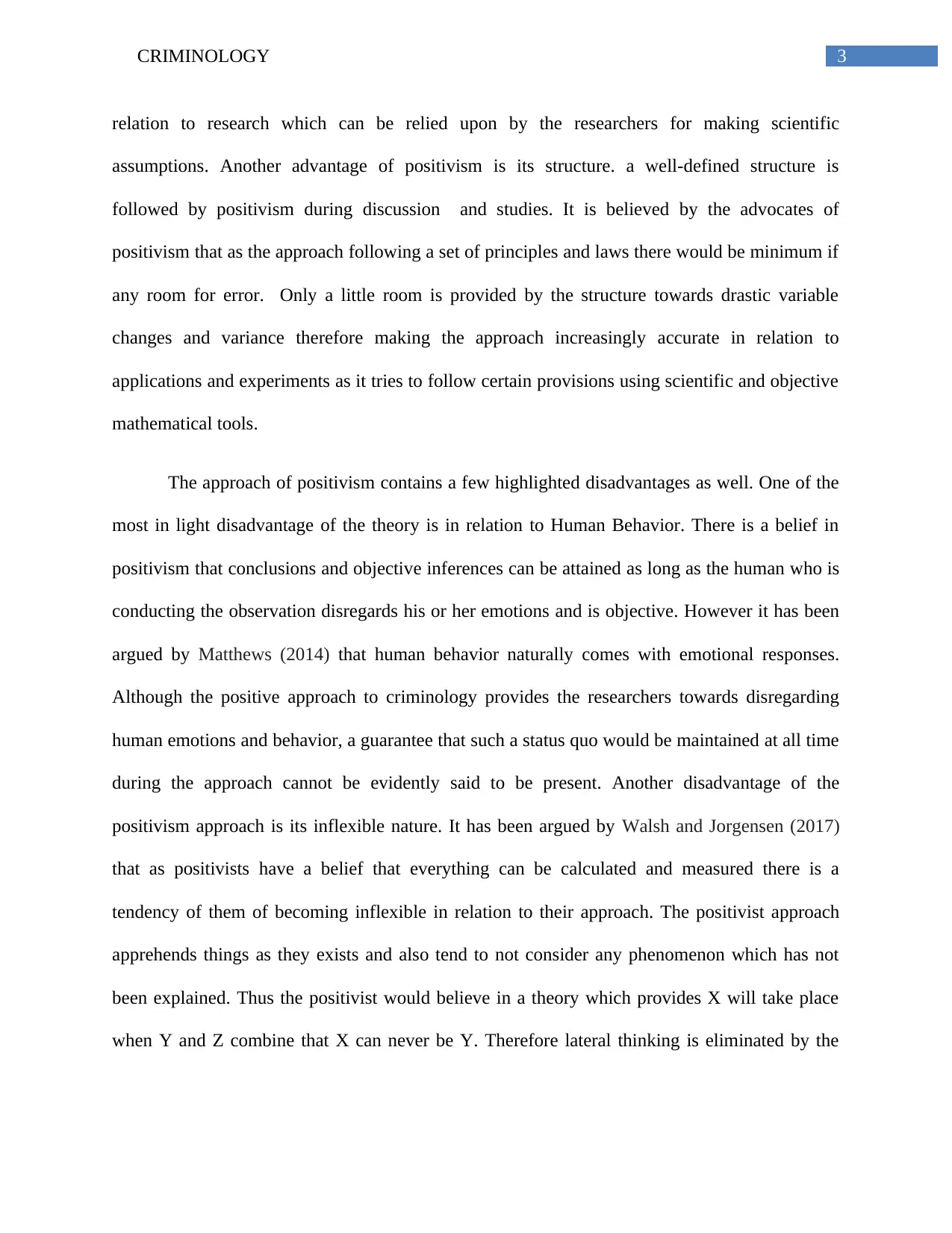
3CRIMINOLOGY
relation to research which can be relied upon by the researchers for making scientific
assumptions. Another advantage of positivism is its structure. a well-defined structure is
followed by positivism during discussion and studies. It is believed by the advocates of
positivism that as the approach following a set of principles and laws there would be minimum if
any room for error. Only a little room is provided by the structure towards drastic variable
changes and variance therefore making the approach increasingly accurate in relation to
applications and experiments as it tries to follow certain provisions using scientific and objective
mathematical tools.
The approach of positivism contains a few highlighted disadvantages as well. One of the
most in light disadvantage of the theory is in relation to Human Behavior. There is a belief in
positivism that conclusions and objective inferences can be attained as long as the human who is
conducting the observation disregards his or her emotions and is objective. However it has been
argued by Matthews (2014) that human behavior naturally comes with emotional responses.
Although the positive approach to criminology provides the researchers towards disregarding
human emotions and behavior, a guarantee that such a status quo would be maintained at all time
during the approach cannot be evidently said to be present. Another disadvantage of the
positivism approach is its inflexible nature. It has been argued by Walsh and Jorgensen (2017)
that as positivists have a belief that everything can be calculated and measured there is a
tendency of them of becoming inflexible in relation to their approach. The positivist approach
apprehends things as they exists and also tend to not consider any phenomenon which has not
been explained. Thus the positivist would believe in a theory which provides X will take place
when Y and Z combine that X can never be Y. Therefore lateral thinking is eliminated by the
relation to research which can be relied upon by the researchers for making scientific
assumptions. Another advantage of positivism is its structure. a well-defined structure is
followed by positivism during discussion and studies. It is believed by the advocates of
positivism that as the approach following a set of principles and laws there would be minimum if
any room for error. Only a little room is provided by the structure towards drastic variable
changes and variance therefore making the approach increasingly accurate in relation to
applications and experiments as it tries to follow certain provisions using scientific and objective
mathematical tools.
The approach of positivism contains a few highlighted disadvantages as well. One of the
most in light disadvantage of the theory is in relation to Human Behavior. There is a belief in
positivism that conclusions and objective inferences can be attained as long as the human who is
conducting the observation disregards his or her emotions and is objective. However it has been
argued by Matthews (2014) that human behavior naturally comes with emotional responses.
Although the positive approach to criminology provides the researchers towards disregarding
human emotions and behavior, a guarantee that such a status quo would be maintained at all time
during the approach cannot be evidently said to be present. Another disadvantage of the
positivism approach is its inflexible nature. It has been argued by Walsh and Jorgensen (2017)
that as positivists have a belief that everything can be calculated and measured there is a
tendency of them of becoming inflexible in relation to their approach. The positivist approach
apprehends things as they exists and also tend to not consider any phenomenon which has not
been explained. Thus the positivist would believe in a theory which provides X will take place
when Y and Z combine that X can never be Y. Therefore lateral thinking is eliminated by the
Paraphrase This Document
Need a fresh take? Get an instant paraphrase of this document with our AI Paraphraser
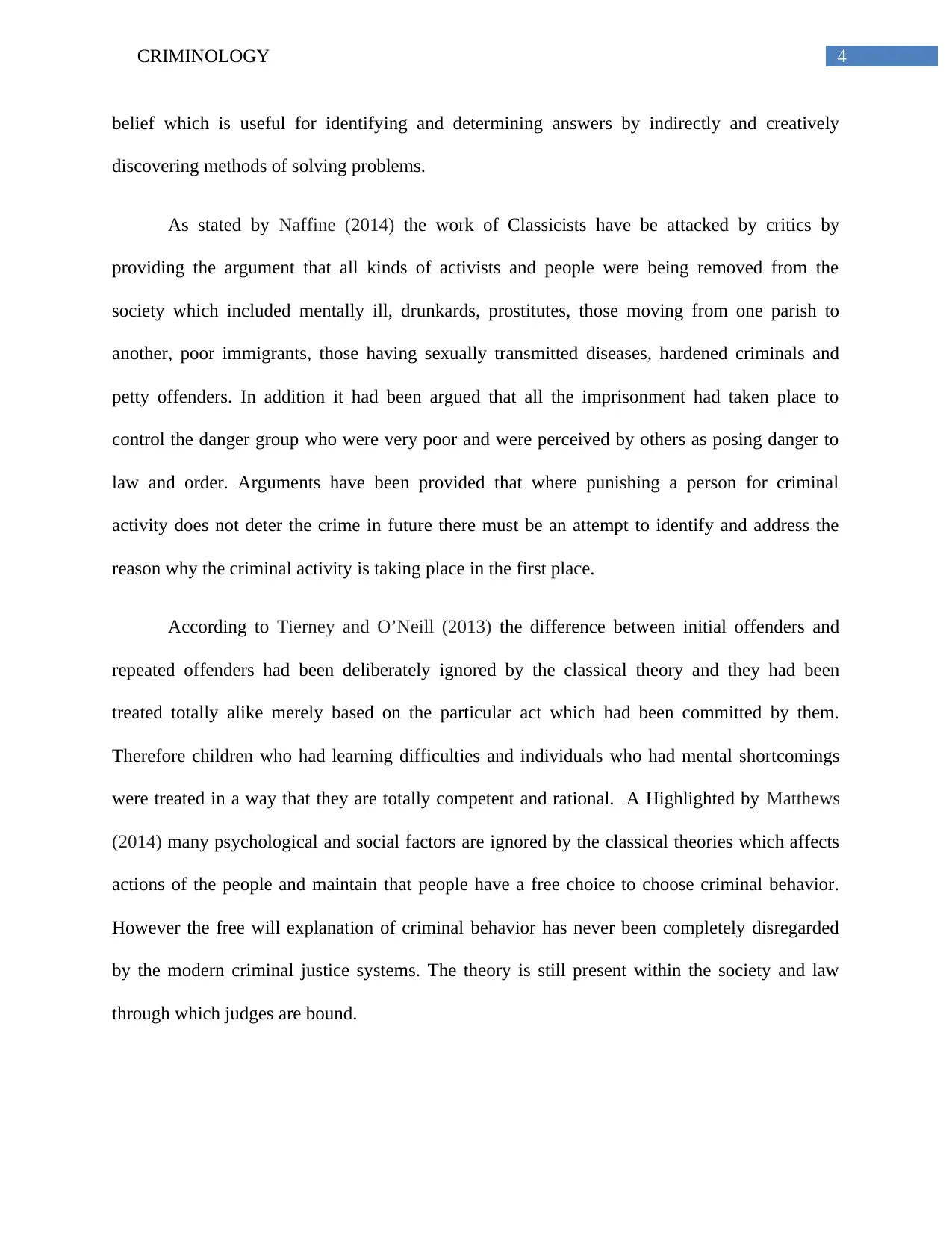
4CRIMINOLOGY
belief which is useful for identifying and determining answers by indirectly and creatively
discovering methods of solving problems.
As stated by Naffine (2014) the work of Classicists have be attacked by critics by
providing the argument that all kinds of activists and people were being removed from the
society which included mentally ill, drunkards, prostitutes, those moving from one parish to
another, poor immigrants, those having sexually transmitted diseases, hardened criminals and
petty offenders. In addition it had been argued that all the imprisonment had taken place to
control the danger group who were very poor and were perceived by others as posing danger to
law and order. Arguments have been provided that where punishing a person for criminal
activity does not deter the crime in future there must be an attempt to identify and address the
reason why the criminal activity is taking place in the first place.
According to Tierney and O’Neill (2013) the difference between initial offenders and
repeated offenders had been deliberately ignored by the classical theory and they had been
treated totally alike merely based on the particular act which had been committed by them.
Therefore children who had learning difficulties and individuals who had mental shortcomings
were treated in a way that they are totally competent and rational. A Highlighted by Matthews
(2014) many psychological and social factors are ignored by the classical theories which affects
actions of the people and maintain that people have a free choice to choose criminal behavior.
However the free will explanation of criminal behavior has never been completely disregarded
by the modern criminal justice systems. The theory is still present within the society and law
through which judges are bound.
belief which is useful for identifying and determining answers by indirectly and creatively
discovering methods of solving problems.
As stated by Naffine (2014) the work of Classicists have be attacked by critics by
providing the argument that all kinds of activists and people were being removed from the
society which included mentally ill, drunkards, prostitutes, those moving from one parish to
another, poor immigrants, those having sexually transmitted diseases, hardened criminals and
petty offenders. In addition it had been argued that all the imprisonment had taken place to
control the danger group who were very poor and were perceived by others as posing danger to
law and order. Arguments have been provided that where punishing a person for criminal
activity does not deter the crime in future there must be an attempt to identify and address the
reason why the criminal activity is taking place in the first place.
According to Tierney and O’Neill (2013) the difference between initial offenders and
repeated offenders had been deliberately ignored by the classical theory and they had been
treated totally alike merely based on the particular act which had been committed by them.
Therefore children who had learning difficulties and individuals who had mental shortcomings
were treated in a way that they are totally competent and rational. A Highlighted by Matthews
(2014) many psychological and social factors are ignored by the classical theories which affects
actions of the people and maintain that people have a free choice to choose criminal behavior.
However the free will explanation of criminal behavior has never been completely disregarded
by the modern criminal justice systems. The theory is still present within the society and law
through which judges are bound.
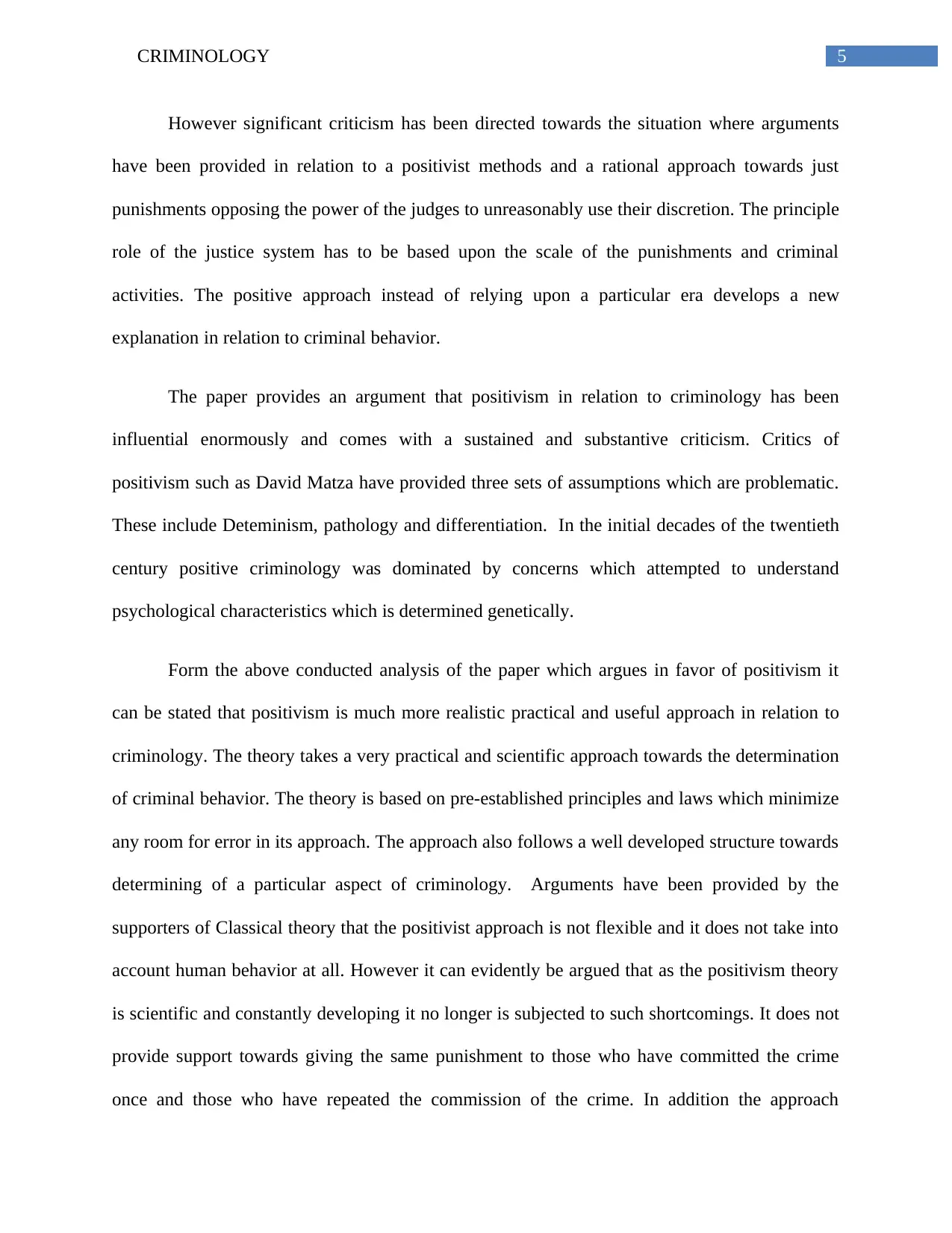
5CRIMINOLOGY
However significant criticism has been directed towards the situation where arguments
have been provided in relation to a positivist methods and a rational approach towards just
punishments opposing the power of the judges to unreasonably use their discretion. The principle
role of the justice system has to be based upon the scale of the punishments and criminal
activities. The positive approach instead of relying upon a particular era develops a new
explanation in relation to criminal behavior.
The paper provides an argument that positivism in relation to criminology has been
influential enormously and comes with a sustained and substantive criticism. Critics of
positivism such as David Matza have provided three sets of assumptions which are problematic.
These include Deteminism, pathology and differentiation. In the initial decades of the twentieth
century positive criminology was dominated by concerns which attempted to understand
psychological characteristics which is determined genetically.
Form the above conducted analysis of the paper which argues in favor of positivism it
can be stated that positivism is much more realistic practical and useful approach in relation to
criminology. The theory takes a very practical and scientific approach towards the determination
of criminal behavior. The theory is based on pre-established principles and laws which minimize
any room for error in its approach. The approach also follows a well developed structure towards
determining of a particular aspect of criminology. Arguments have been provided by the
supporters of Classical theory that the positivist approach is not flexible and it does not take into
account human behavior at all. However it can evidently be argued that as the positivism theory
is scientific and constantly developing it no longer is subjected to such shortcomings. It does not
provide support towards giving the same punishment to those who have committed the crime
once and those who have repeated the commission of the crime. In addition the approach
However significant criticism has been directed towards the situation where arguments
have been provided in relation to a positivist methods and a rational approach towards just
punishments opposing the power of the judges to unreasonably use their discretion. The principle
role of the justice system has to be based upon the scale of the punishments and criminal
activities. The positive approach instead of relying upon a particular era develops a new
explanation in relation to criminal behavior.
The paper provides an argument that positivism in relation to criminology has been
influential enormously and comes with a sustained and substantive criticism. Critics of
positivism such as David Matza have provided three sets of assumptions which are problematic.
These include Deteminism, pathology and differentiation. In the initial decades of the twentieth
century positive criminology was dominated by concerns which attempted to understand
psychological characteristics which is determined genetically.
Form the above conducted analysis of the paper which argues in favor of positivism it
can be stated that positivism is much more realistic practical and useful approach in relation to
criminology. The theory takes a very practical and scientific approach towards the determination
of criminal behavior. The theory is based on pre-established principles and laws which minimize
any room for error in its approach. The approach also follows a well developed structure towards
determining of a particular aspect of criminology. Arguments have been provided by the
supporters of Classical theory that the positivist approach is not flexible and it does not take into
account human behavior at all. However it can evidently be argued that as the positivism theory
is scientific and constantly developing it no longer is subjected to such shortcomings. It does not
provide support towards giving the same punishment to those who have committed the crime
once and those who have repeated the commission of the crime. In addition the approach
⊘ This is a preview!⊘
Do you want full access?
Subscribe today to unlock all pages.

Trusted by 1+ million students worldwide

6CRIMINOLOGY
differentiates between those who are mentally not sound and those who intentionally indulge in
criminal activities.
differentiates between those who are mentally not sound and those who intentionally indulge in
criminal activities.
Paraphrase This Document
Need a fresh take? Get an instant paraphrase of this document with our AI Paraphraser
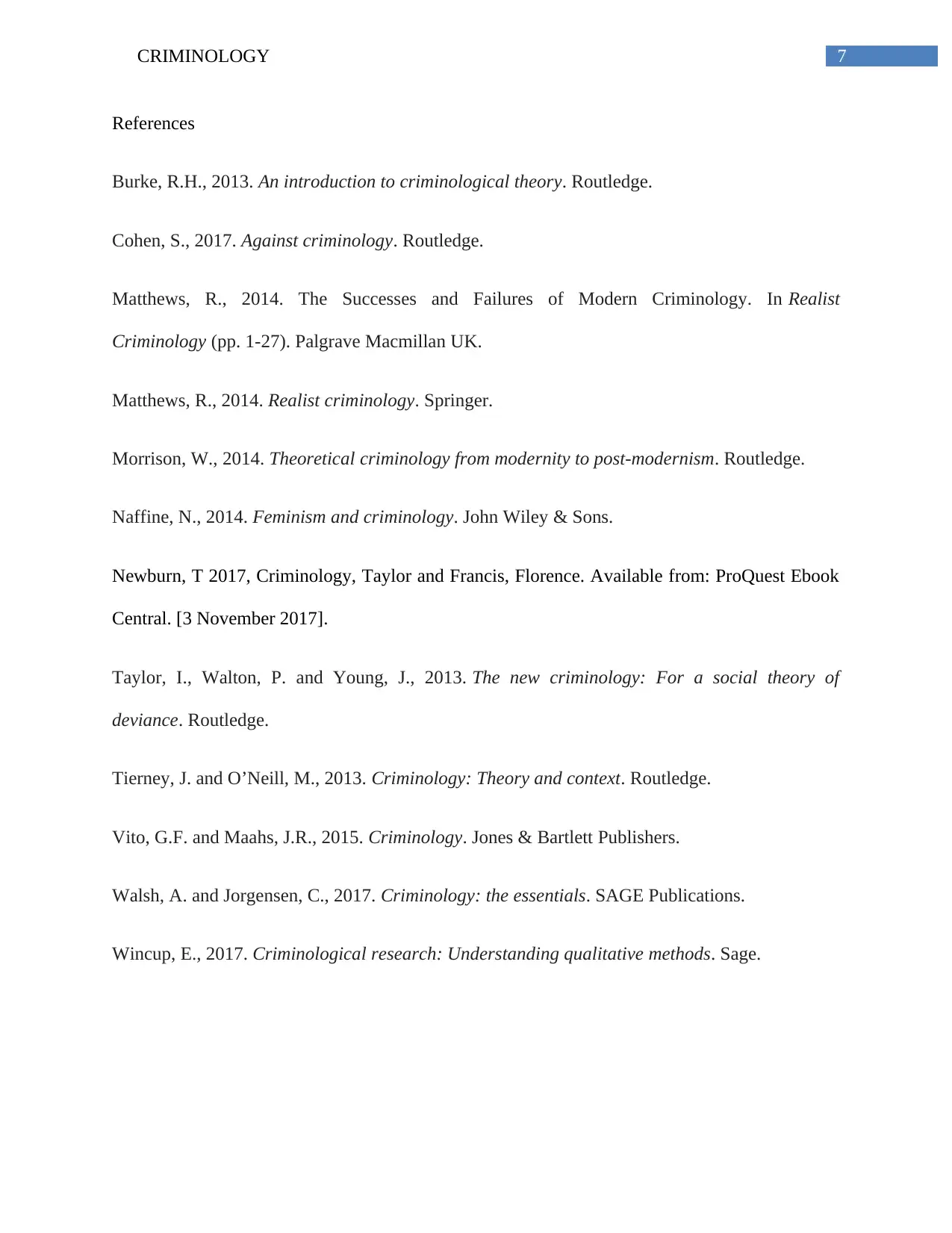
7CRIMINOLOGY
References
Burke, R.H., 2013. An introduction to criminological theory. Routledge.
Cohen, S., 2017. Against criminology. Routledge.
Matthews, R., 2014. The Successes and Failures of Modern Criminology. In Realist
Criminology (pp. 1-27). Palgrave Macmillan UK.
Matthews, R., 2014. Realist criminology. Springer.
Morrison, W., 2014. Theoretical criminology from modernity to post-modernism. Routledge.
Naffine, N., 2014. Feminism and criminology. John Wiley & Sons.
Newburn, T 2017, Criminology, Taylor and Francis, Florence. Available from: ProQuest Ebook
Central. [3 November 2017].
Taylor, I., Walton, P. and Young, J., 2013. The new criminology: For a social theory of
deviance. Routledge.
Tierney, J. and O’Neill, M., 2013. Criminology: Theory and context. Routledge.
Vito, G.F. and Maahs, J.R., 2015. Criminology. Jones & Bartlett Publishers.
Walsh, A. and Jorgensen, C., 2017. Criminology: the essentials. SAGE Publications.
Wincup, E., 2017. Criminological research: Understanding qualitative methods. Sage.
References
Burke, R.H., 2013. An introduction to criminological theory. Routledge.
Cohen, S., 2017. Against criminology. Routledge.
Matthews, R., 2014. The Successes and Failures of Modern Criminology. In Realist
Criminology (pp. 1-27). Palgrave Macmillan UK.
Matthews, R., 2014. Realist criminology. Springer.
Morrison, W., 2014. Theoretical criminology from modernity to post-modernism. Routledge.
Naffine, N., 2014. Feminism and criminology. John Wiley & Sons.
Newburn, T 2017, Criminology, Taylor and Francis, Florence. Available from: ProQuest Ebook
Central. [3 November 2017].
Taylor, I., Walton, P. and Young, J., 2013. The new criminology: For a social theory of
deviance. Routledge.
Tierney, J. and O’Neill, M., 2013. Criminology: Theory and context. Routledge.
Vito, G.F. and Maahs, J.R., 2015. Criminology. Jones & Bartlett Publishers.
Walsh, A. and Jorgensen, C., 2017. Criminology: the essentials. SAGE Publications.
Wincup, E., 2017. Criminological research: Understanding qualitative methods. Sage.
1 out of 8
Related Documents
Your All-in-One AI-Powered Toolkit for Academic Success.
+13062052269
info@desklib.com
Available 24*7 on WhatsApp / Email
![[object Object]](/_next/static/media/star-bottom.7253800d.svg)
Unlock your academic potential
Copyright © 2020–2025 A2Z Services. All Rights Reserved. Developed and managed by ZUCOL.





